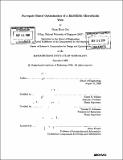| dc.contributor.advisor | Karen E. Willcox and Theresa D. Robinson. | en_US |
| dc.contributor.author | Ooi, Boon Hooi | en_US |
| dc.contributor.other | Massachusetts Institute of Technology. Computation for Design and Optimization Program. | en_US |
| dc.date.accessioned | 2009-04-29T17:19:15Z | |
| dc.date.available | 2009-04-29T17:19:15Z | |
| dc.date.copyright | 2008 | en_US |
| dc.date.issued | 2008 | en_US |
| dc.identifier.uri | http://hdl.handle.net/1721.1/45276 | |
| dc.description | Thesis (S.M.)--Massachusetts Institute of Technology, Computation for Design and Optimization Program, 2008. | en_US |
| dc.description | Includes bibliographical references (p. 127-130). | en_US |
| dc.description.abstract | BioMEM microfluidic weirs enable biologists to study biological processes at the cell level. A novel substrate-affixed microfluidic array of weirs allows active sorting of cells via control electrodes. The ability of the weirs to retain cells hydrodynamically is vital to the functionality of the substrate-affixed array of weirs. The objective of this thesis is to give insight using numeric tools to the microfluidic weir designer on how to improve the ability of the microfluidic weir to retain cells. Simulations of the interactions between the cell and the weir were performed using a computer simulation of Stokes flow. The computational approach uses a pre-corrected Fast Fourier Transform Boundary Element Method to evaluate the drag forces acting on the cell and a rigid body physics library to handle rigid body collision dynamics between the cell and the weir. This model was used to address two research questions which are the two main discussions of the thesis. The first discussion studies in detail the mechanisms behind the 'Around The Side' (ATS) and 'Over The Top' (OTT) modes of escape that were observed experimentally. A model example was studied for each mode. The forces and torques experienced by the cell when it escaped through either mode are explained in detail. Each mode was segmented into time periods and the mechanisms behind these modes of escape were discussed to give insight to the microfluidic weir designer. The second discussion focuses on design space exploration and optimization of the ability of the microfluidic weir to retain the cell. In order to make design optimization computationally tractable a surrogate is derived; that is, a model that provides an accurate approximation to the input/output map of the simulation but that is much cheaper computationally to evaluate. | en_US |
| dc.description.abstract | (cont.) The surrogate was built using the Support Vector Machine (SVM) algorithm and was then used for the design space exploration and optimization. The weir geometry and flow rate were used as design variables to maximize the ability of the microfluidic weir to retain cells in the design optimization problem. Results from the design space exploration and optimization showed that a minimal depth of the mouth of the weir is required for the weir to be able to retain any beads. However, the ability of the weir to retain beads is more sensitive to the width of the mouth than the depth. | en_US |
| dc.description.statementofresponsibility | by Boon Hooi Ooi. | en_US |
| dc.format.extent | 130 p. | en_US |
| dc.language.iso | eng | en_US |
| dc.publisher | Massachusetts Institute of Technology | en_US |
| dc.rights | M.I.T. theses are protected by
copyright. They may be viewed from this source for any purpose, but
reproduction or distribution in any format is prohibited without written
permission. See provided URL for inquiries about permission. | en_US |
| dc.rights.uri | http://dspace.mit.edu/handle/1721.1/7582 | en_US |
| dc.subject | Computation for Design and Optimization Program. | en_US |
| dc.title | Surrogate-based optimization of a BioMEMs microfluidic weir | en_US |
| dc.type | Thesis | en_US |
| dc.description.degree | S.M. | en_US |
| dc.contributor.department | Massachusetts Institute of Technology. Computation for Design and Optimization Program | |
| dc.identifier.oclc | 310970842 | en_US |
